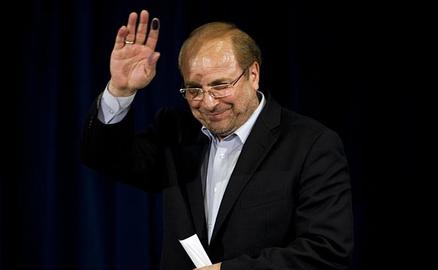Hassan Rouhani is the fourth president of the Islamic Republic to serve a second term under the Supreme Leader Ayatollah Khamenei. So does history tell us what we can expect from Rouhani’s second term, and in particular, his relationship with the supreme leader and the Revolutionary Guards? Rouhani's cabinet choices will give some indication of his intentions and political plans — and how he hopes to manage relationships with Iran's most powerful people.
The first president to serve two terms under Khamenei was the late Akbar Hashemi Rafsanjani. During his second term, Rafsanjani’s personal relationship with Khamenei remained cordial, but it also witnessed the rise of considerable political tensions between their supporters. These tensions gave birth to new political coalitions, including the Executives of Construction Party, a liberal-leaning party founded in 1996 by 16 members of Rafsanjani’s cabinet. The new coalition was a response to conservative politicians’ refusal to endorse candidates the president had supported for parliament. Then, during the 1997 presidential election, Rafsanjani’s allies backed a candidate who was not a Khamenei favorite, laying the groundwork for future conflicts. Even so, the good relations between Rafsanjani and Khamenei kept most of these tensions under control.
The second president to serve two terms was Mohammad Khatami. During his first term, as expected, there were tensions between him and the supreme leader. During his second term the tensions, comparatively speaking, subsided. This was mainly due to Khatami’s political character, and the fact that he tried to reduce strife in domestic politics and, later, to the defeat of reformists in the 2004 parliamentary elections — a political shift which ushered in the era of the conservative principlists’ ascendance. Even with this shift, relations between Khatami and Khamenei remained normal until the end of Khatami’s second term.
The third president was Mahmoud Ahmadinejad. His second term followed the disputed 2009 presidential election and was fraught with major strains and tensions. This was mainly due to Ahmadinejad’s shows of defiance toward Khamenei and the resulting division between his supporters and the close allies of the supreme leader. Ahmadinejad was not able to create an effective coalition among the higher echelons of Iran’s power structure and his clashes with various political factions led to frequent crises that forced Khamenei to step in — which, in turn, further damaged their relationship.
Significant Differences
The Guardian Council rejected Ahmadinejad’s and Rafsanjani’s attempts to run for president again, in 2013 and 2017 respectively. Given that Khatami, a reformist, is so widely vilified by conservatives, including people with close relationships with Ayatollah Khamenei, any attempt he made to run again would no doubt be rejected. But apart from this, there is no common pattern for Iran’s two-term presidents, making it extremely tricky to predict what will happen between Rouhani and Khamenei, or between Rouhani and Iran’s powerful institutions over the next four years.
One very important difference between Rouhani and former presidents who have served under Khamenei is that it is possible that the Islamic Republic may soon have a new supreme leader. This, perhaps, makes Rouhani’s second term similar to Khamenei’s own second term as president under Ayatollah Khomeini. Khomeini died in 1989 and was succeeded by Khamenei.
The sudden death of Hashemi Rafsanjani on January 8 has not necessarily led to an increase in speculations about when Khamenei will die, but it was a reminder that it will happen relatively soon — and that the impact will be enormous. This awareness, then, may set the scene for new coalitions to emerge, and for existing groups to fortify their efforts and ideologies, a definite feature of Khomeini’s last years. What has made the current situation more complex is serious divisions among the principlists, many of whom are pitted against one another.
Although the president has many enemies among conservative principlists, one powerful group does not oppose Rouhani. On the contrary, this group has tried to defuse tensions between Rouhani on one side Khamenei and the Revolutionary Guards on the other. Parliament Speaker Ali Larijani and Ali Akbar Nategh-Nouri, the former speaker who recently resigned as the head of Khamenei’s Inspection Office, are the group’s most two prominent members.
In addition, the post-sanctions period Iran is experiencing today resembles the period following the end of the eight-year Iran-Iraq war. The war came to an end in August 1988, less than a year before Khomeini’s death, and led to realignments in Iranian politics. But in many ways, this is a unique period: It’s the first time in decades that international relations have had such an impact on Iranian domestic politics.
But regardless of this bigger picture, Rouhani’s own political persona and actions could play a very decisive role. During the recent election campaign, he played the role of an opposition candidate, prompting speculations about his future political approach. Perhaps these speculations can give us some clues about Rouhani’s second term, and about how he will shape his cabinet. Although the supreme leader has the power to decide about key cabinet ministers, the cabinet is the president’s main tool for implementing his agenda and neutralizing his opponents. Who Rouhani chooses to work with could be a rather good indicator of how and where he wants to fight or compromise. His choices for cabinet will make clear his priorities and his inclinations. These decisions will most likely indicate what kind of relations he wants to have with parliament, and with other institutions of power. And, crucially, it will give an indication of how he plans to interact with the Revolutionary Guards — which all but swore loyalty to his chief rival Ebrahim Raeesi during the 2017 presidential election.
Choosing his cabinet is the first step for Rouhani, an important set of decisions that will lay the foundations for his next four years as president.
visit the accountability section
In this section of Iran Wire, you can contact the officials and launch your campaign for various problems
























comments